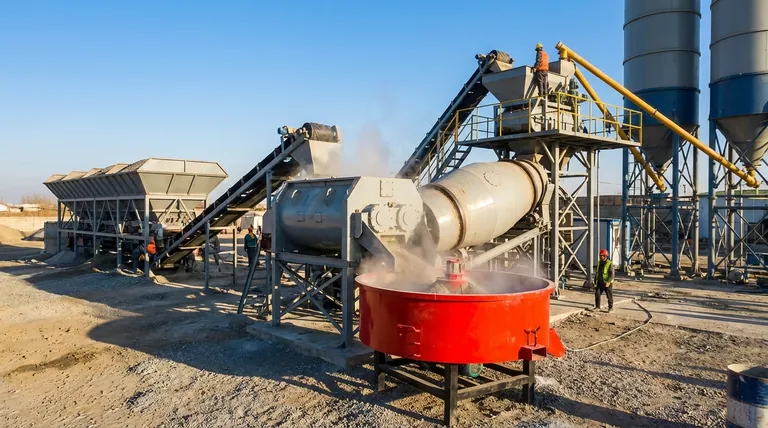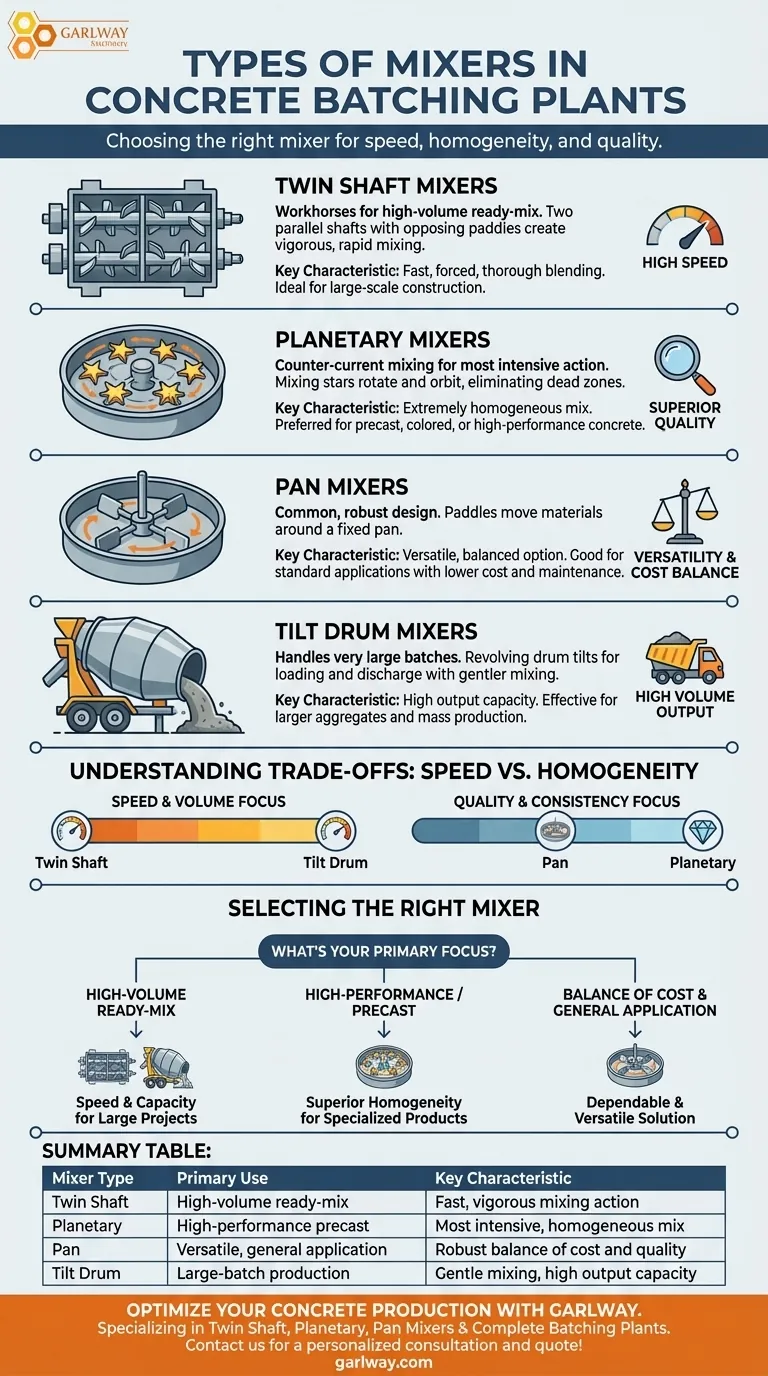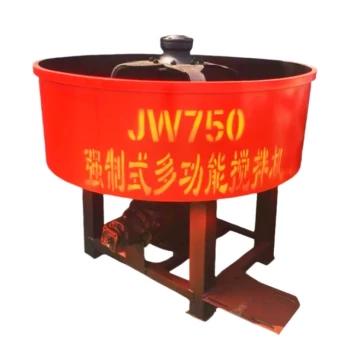The primary types of mixers used in a concrete batching plant are twin shaft, planetary, pan, and tilt drum mixers. Each is engineered with a distinct mixing action to produce different types of concrete, from high-volume ready-mix to high-performance precast products. The choice of mixer directly impacts the speed of production, the homogeneity of the mix, and the overall quality of the final concrete.
The selection of a concrete mixer is not about finding the "best" type, but about matching the mixer's specific mechanical action to the performance requirements of the concrete and the operational demands of the project.

The Core Mixer Types Explained
Understanding the mechanics of each mixer reveals its intended application. The primary difference lies in how the paddles or drums agitate the raw materials—cement, water, and aggregates—to create a uniform mixture.
Twin Shaft Mixers
Twin shaft mixers are the workhorses for high-volume concrete production. They use two parallel, horizontal shafts with mixing paddles that rotate in opposite directions, creating a highly efficient and vigorous mixing action.
This design ensures a forced, thorough, and rapid blending of materials, making it ideal for producing large quantities of ready-mix concrete quickly. They are especially prevalent in Europe and many other parts of the world for large-scale construction.
Planetary Mixers
Planetary mixers, also known as counter-current mixers, provide the most intensive mixing action. They feature one or more mixing stars that rotate on their own axes while also revolving around a central point in the mixer, like planets orbiting the sun.
This complex movement guarantees that every point within the mixing pan is passed over, eliminating dead zones and producing an extremely homogeneous mix. This makes them the preferred choice for precast plants and for producing high-performance, colored, or fiber-reinforced concrete.
Pan Mixers
Pan mixers are a common and effective design where mixing paddles rotate through the material inside a stationary, circular pan. The movement forces the materials to blend as they are moved around the pan.
While simpler than a planetary mixer, this design is robust and well-suited for a variety of standard concrete applications. They offer a good balance between mixing quality, cost, and maintenance.
Tilt Drum Mixers
Tilt drum mixers are characterized by a revolving drum that is tilted up to load materials and tilted down to discharge the mixed concrete. The mixing action is gentler, relying on the rotation of the drum and internal fins to lift and drop the materials.
This type is capable of handling very large batches and is the predominant choice in North America for mass concrete production. It is highly effective for mixing larger aggregates and achieving high output.
Understanding the Trade-offs: Speed vs. Homogeneity
The different mixer designs present a clear trade-off between the speed of production and the intensity of the mixing action, which directly influences the concrete's uniformity.
Focus on Speed and Volume
Twin shaft and tilt drum mixers are engineered for output. Their primary advantage is the ability to mix and discharge large batches of concrete in a very short cycle time, making them essential for projects that demand a continuous, high-volume supply.
Focus on Quality and Consistency
Planetary mixers prioritize mix quality above all else. Their comprehensive mixing action is slower but far more thorough, which is critical for specialized concrete where consistency in strength, color, and texture is non-negotiable.
Focus on Versatility and Cost
Pan mixers represent a middle ground. They deliver a reliable, homogenous mix suitable for many applications without the mechanical complexity or higher cost of a planetary system, making them a versatile and economical choice.
Selecting the Right Mixer for Your Project
Choosing the correct mixer is a foundational decision that affects both operational efficiency and the structural integrity of the final product.
- If your primary focus is high-volume ready-mix concrete: A twin shaft or tilt drum mixer provides the speed and capacity required for large-scale civil projects.
- If your primary focus is high-performance or precast concrete: A planetary mixer is essential to achieve the superior homogeneity and consistency needed for architectural panels, specialized blocks, or fiber-reinforced products.
- If your primary focus is a balance of cost and general application: A pan mixer offers a dependable and versatile solution for a wide range of standard concrete needs.
Ultimately, aligning the mixer's capabilities with the specific demands of your concrete mix is the key to ensuring quality and performance.
Summary Table:
| Mixer Type | Primary Use | Key Characteristic |
|---|---|---|
| Twin Shaft | High-volume ready-mix | Fast, vigorous mixing action |
| Planetary | High-performance precast | Most intensive, homogeneous mix |
| Pan | Versatile, general application | Robust balance of cost and quality |
| Tilt Drum | Large-batch production | Gentle mixing, high output capacity |
Ready to Optimize Your Concrete Production?
Choosing the right mixer is critical to your project's efficiency and the final quality of your concrete. GARLWAY specializes in providing construction companies and contractors with the ideal concrete batching plant solutions, including high-performance twin shaft mixers, planetary mixers, pan mixers, and concrete batching plants.
Let our experts help you select the perfect mixer to match your specific needs for speed, homogeneity, and volume.
Contact GARLWAY today for a personalized consultation and quote!
Visual Guide

Related Products
- Ready Mixer Machine for Construction Ready Mix Machinery
- Commercial Construction Mixer Machine for Soil Cement Mixing Concrete
- Portable Concrete Mixer Machine Equipment for Mixing Concrete
- Hydraulic Concrete Mixer Machine Cement Mixing Equipment for Mixture Concrete
- HZS25 Best Cement Mixer for Quick Mix Concrete at Bunnings
People Also Ask
- What is the function of a concrete mixer machine? Achieve Consistent, High-Quality Concrete for Your Projects
- What should be considered regarding the output of a concrete mixer? Match Capacity to Your Project Scale
- Can a concrete mixer be used for mortar? Understanding the trade-offs for your project
- Why is the manufacturer's strength and service important when choosing a concrete mixer? Ensure Long-Term Project Success
- When was the first concrete mixer developed and by whom? Discover the 1900 Breakthrough


















